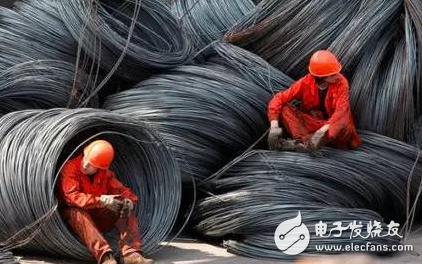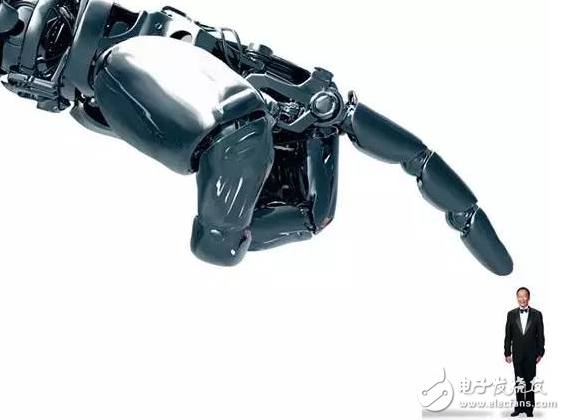What determines the fourth industrial revolution is the industrial population. This is also the reason why China will become the world's largest industrial country. This is also the inevitable law of historical development. Three industrial revolutions have phased out countries with small industrial population In the middle and late 19th century, the industrial system only had the power of steam engines. At that time, the most complicated industrial products were nothing more than iron-clad ships. There were hundreds of thousands of parts and components in an iron-clad ship. So an industrial country at that time needed nearly one million people to meet the core industry. The industrial country of Belgium also has a population of 4 million. After the second industrial revolution in the early 20th century, the two major categories of electrical and chemical industries were added. The basic parts and components of the industrial system have also been multiplied several times. It is necessary for nearly 10 million core industries to maintain the integrity of the industrial system. At this time, the Belgian stream is no longer included in the powers. The least populous country is 40 million people, and the French industrial system is not complete. When more than 60 million people come to Germany, they must first play with the support of the United States and the United States. World War II. By the time of World War II, the basic components had increased to several million, corresponding to 65 million people in Germany to wage war, and France to be out one month after the start of the war. But Germany must also abandon the development and production of super-weapons such as strategic bombers, aircraft carriers and atomic bombs. Japan, which has a similar population, can not make a decent tank. On the sea floor, there are only a hundred Americans with a population of 100 million. The Soviet Union lacked reserves in naval technology, but tanks, artillery, and rockets could always push Germany. When the world enters the nuclear age, a complete industrial system needs to consist of tens of millions of industrial basic accessories, which determines that only the industrial country with a population of 100 million, that is, the United States and the Soviet Union are eligible to become the world level (China has a large population at this time) However, the proportion of the industrial population is extremely low. Other industrial countries can only do vassals. During this period of time, although Britain and France are both permanent members of the Security Council and have strategic nuclear weapons, they can only face the fate of the river. Even with many small countries, the third industrial revolution is already the limit. Europe's final integration process is not because the EU wants, but if it does not integrate the industrial population and manufacturing capacity of the 20 countries in Europe to form an entity with a population of hundreds of millions of people, Europe will not continue. However, according to the current EU birth rate and population size, the third industrial revolution is its limit. The requirements of the fourth industrial revolution on the complexity of the entire industrial chain and the number of industrial workers are all unaffordable by the EU. . For example, a fighter that represents a country's high-end industrial system, only two countries that are currently able to meet the fourth-generation fighter standard, China and the United States. The Russian T50, which was flattened by Su27, is not counted. In Europe, no country can independently afford the development of the fourth-generation fighter. The three-and-a-half typhoon fighters are the peak of the total force of Europe. The fourth-generation fighter F35 can only be Developed jointly with the United States. But even if Europe and the United States joined forces in a country, such as Japan and South Korea, the entire development process has been exhausted. The industrial revolution is a process from quantitative change to qualitative change. After each industrial revolution, new technical means will greatly improve manufacturing precision. Once the accuracy of the machine is increased, the next change is the machine that can make more complex products. The more complex the product, the more parts it contains. These parts need to be manufactured. So how many kinds of parts in an industrial system basically require how many workers and technicians master the manufacturing process. The reason why we always use the industrial population instead of the population is because not everyone can adapt to the life of the industrial society. Only with a certain level of knowledge, can enter the factory, standardize the work that they are responsible for, and become the whole factory. A qualified worker can only be considered a well-functioning worker. Like India, being able to write your own name is not illiterate. Even if you give the simplest equipment to them, they will destroy it in minutes. Cultivating qualified workers is a very difficult and time-consuming task, and everyone who has not completed the transition to an industrial population is more of a national burden than a motivation. If you think that Industry 4.0 is a machine to replace people, then you are wrong. Although the characteristics of the industrial age are machine-building machines, the design and manufacture of machines, the ultimate in operating machines depends on people, relying on the industrial population of a country. The development trend of modern industry is divided into layers, subdivided into layers, products are more and more complex, basic accessories are more and more, industrial chains are getting longer and longer, and the supporting industrial chains are becoming more and more complicated. Every machine and equipment is made up of a large number of parts. To ensure the normal operation of the industry, it must be ensured that every part has sufficient backup. To produce, it is necessary to have countless parts to be produced. The design, manufacture and improvement of each part must be completed after long-term research, reflection and experimentation. No one can carry out secondary development and upgrade based on unfamiliar products. Without long-term research and use, the industry cannot make progress. Therefore, in industrial production, at least one full-time staff should have at least one full-time staff to research and produce, and at the same time, at least one apprentice must be passed down in the process of learning. With the development of industrialization, the complexity of machinery and equipment has increased, the industrial population of the core industry and the complexity of industrial technology, as well as the number of basic accessories have increased in the same proportion. It is impossible to form a complete society by the core industry alone. With heavy industry, there must be a consumer goods industry, construction industry, transportation, commerce, agriculture, mining, education, and service industries. The military construction needs to guarantee the social security of the people's livelihood. These industries require a large labor force. Only when these industries are in place, can the industrial system operate smoothly and the people can have a high quality, guaranteed, relaxed and relatively rich life. These labor populations also have children and old people who need to be raised and who lack sufficient labor capacity. Therefore, the population required for an independent, complete industrial system is approximately 10 times the number of basic components and must not be less than 5 times. Especially in heavy industry, it is the place where machines for manufacturing machines are produced, shouldering the heavy responsibility of technological upgrading. Technology upgrades, the development of a new generation of mechanical equipment, the need for a large number of high-quality talents to charge the unknown, spending a lot of time and resources, in the countless failures and experience summaries, get that little poor, feasible Technology upgrade route. When can robots really replace humans? To see the development of artificial intelligence, one criterion is that machines can create machines that are more complex than themselves. The industrial revolution only changed the type of work, from low-end to high-end In Europe, many prophets have pessimistically portrayed the “catastrophic†scenario of the future industry: factories are empty, isolated, human jobs are replaced by machines, and unemployment is high? This is not the case, even in In the era of Industry 4.0, there will be no one in the factory. The role of people in the manufacturing process will be transformed from a server and an operator to a planner, coordinator, evaluator, and decision maker. This change brings about the abandonment of low-end labor demand and the need to put more manpower demand at the high end. Every industrial revolution will dilute and reduce the manpower of some traditional industries, but will enrich the overall industrial personnel category, such as the Internet. In the industrial age, small countries and widows mean no ability to master the destiny of their country! Not afraid of the technical blockade of countries such as Europe and the United States, but they are afraid According to the results of the US "New York Times" survey, the advantages of Chinese industry in competition today are more reflected in the complete supply chain. For example, China is the only country in the world that has all the industrial categories in the UN industry classification (39 industrial categories, 191 medium categories, 525 subcategories), forming an industrial system with “complete, independent and complete categoriesâ€. From basic parts such as screws to communication, aerospace and high-speed rail, the complete industrial chain ensures that China can firmly hold its irreplaceable position in the world industrial market. And this is also due to the large industrial population. For China, such a large population base, with an industrial population equivalent to Europe and the United States, can avoid repeating the Soviet Union or Japan's mistakes and rely on its own strength to complete its own industrial upgrading. When China's own communication technology standard TD-CDMA was able to break through the suppression of Europe and the United States, it became one of the four major standards in the world. In fact, it has an important relationship with China's population. Once the Western technological blockade is implemented, the possibility of a domestic turbulent coup is even higher. For China, it is only a small wave. This kind of killing of one thousand people hurts 10,000, and the price is not affordable to the West. The fourth industrial revolution will make China According to the law that every basic component of every industrial revolution needs to increase by several orders of magnitude, the fourth industrial revolution requires a population threshold of at least 1 billion. The United States wants to establish a complete new industrial system after the fourth revolution, and merge. The whole of South America and Europe will be said again. The fourth industrial revolution will break out. No one can be sure. The only thing that can be done is the full investment of the whole industry. Anyway, there is always one that is correct. However, the amazing demand for manpower and material resources of this big net fishing fish has made many high-level projects only play in China, the United States and Russia, and many of them have already played in both China and the United States. If you think that globalization is now, why should the company have to open to China because this large and complete industrial system has a high degree of flexibility based on the agglomeration effect of many industrial enterprises. As a former Apple executive told the New York Times, “You need 1000 rubber washers? There is a factory next door. You need 1 million screws? There is a factory next door. You need to make a little screw. Change? Three hours will be fine.†Obviously, Chinese industrial enterprises have some characteristics of synergy and flexibility in the future networked industrial era, and paved the way for the realization of “Industry 4.0†in the future.
Power Bank is a portable charger that can be carried by individuals and reserves power by itself. It is mainly used to charge consumer electronic products such as handheld mobile devices (such as wireless phones and laptops), especially when there is no external power supply. Its main components include: a battery for electrical energy storage, a circuit (DC-DC converter) to stabilize the output voltage, and most mobile power supplies come with a charger for charging as a built-in battery.
Whaylan always adhere to the concept of "innovation drives development, science and technology leads the future", product research and development is quality-oriented, efficient-based, safety-oriented as the principle, the establishment of a strong, experienced R & D team, the company has been rated as science and technology small and medium-sized enterprises, specialized new enterprises, high-tech enterprises.
ince its establishment, the company has always adhered to the original intention of "let the whole world use clean energy", deeply plough into the field of power, electronic and electric energy transformation, and is committed to providing smart energy management and other overall solutions for families, industrial and commercial users and ground power stations with innovative technology, excellent products and professional services.
65W Power Bank,best power bank 20000mah,best power banks,portable charger suzhou whaylan new energy technology co., ltd , https://www.nbwhaylan.com


